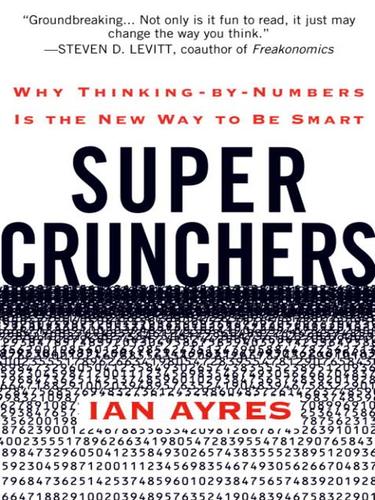chadkoh reviewed Super Crunchers by Ian Ayres
Review of 'Super Crunchers' on 'Goodreads'
3 stars
Imagine [b:The Deciding Factor|6348143|The Deciding Factor The Power of Analytics to Make Every Decision a Winner|Larry E. Rosenberger|http://photo.goodreads.com/books/1256145407s/6348143.jpg|6534651] rewritten by someone with a sense of humour rather than a copywriter for a huge data-mining company, mix in a little of [b:The Long Tail|2574|The Long Tail Why the Future of Business Is Selling Less of More|Chris Anderson|http://photo.goodreads.com/books/1161107539s/2574.jpg|989032], some [a:Malcolm Gladwell|1439|Malcolm Gladwell|http://photo.goodreads.com/authors/1224601838p2/1439.jpg], and you get this book. Mostly the book presents how regression analysis and randomized testing are used in a series of anecdotal stories. It does not go into how these numbers are crunched, just how the results can be used. The only thing I learned here was the concept of "making your own data" using randomized testing. That was an interesting way to look at it. The final chapters were the best — focusing on standard deviations and Bayesian statistics — but only scratched the surface. No substance.
This book …
Imagine [b:The Deciding Factor|6348143|The Deciding Factor The Power of Analytics to Make Every Decision a Winner|Larry E. Rosenberger|http://photo.goodreads.com/books/1256145407s/6348143.jpg|6534651] rewritten by someone with a sense of humour rather than a copywriter for a huge data-mining company, mix in a little of [b:The Long Tail|2574|The Long Tail Why the Future of Business Is Selling Less of More|Chris Anderson|http://photo.goodreads.com/books/1161107539s/2574.jpg|989032], some [a:Malcolm Gladwell|1439|Malcolm Gladwell|http://photo.goodreads.com/authors/1224601838p2/1439.jpg], and you get this book. Mostly the book presents how regression analysis and randomized testing are used in a series of anecdotal stories. It does not go into how these numbers are crunched, just how the results can be used. The only thing I learned here was the concept of "making your own data" using randomized testing. That was an interesting way to look at it. The final chapters were the best — focusing on standard deviations and Bayesian statistics — but only scratched the surface. No substance.
This book seems directed at an older audience, unfamiliar with even the most basic conception of our data-filled world (I mean, he uses floppy disks in one of his data size metaphors!).

